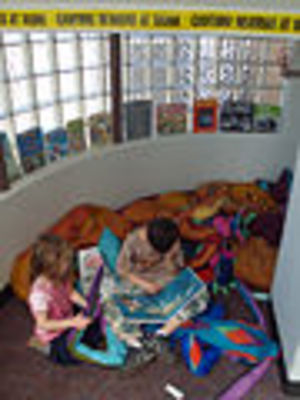The role of reading centers in the primary classroom is to offer engaging, hands-on learning activities that promote reading skills and an interest in reading. Reading centers, as with all centers, are a supplement to large group, small group and one on one reading reading lessons. Reading centers can be created at home or in a homeschool classroom as well traditional elementary school classrooms.
Reading centers take time to set and up and organize but when well done can be a wonderful classroom management tool that offers rewarding learning opportunities for students.
Reading Center Tips:
Reading centers should be attractive and comfortable.
Reading centers should be labeled for a limit of students, generally one, two or three at a time.
Reading centers should be set up to be relatively independent learning opportunities once students have been made familiar with the activities, supplies, goals and rules of each reading center.
Reading centers should be varied to address a variety of learning styles and interest.
Every student should have the opportunity to visit reading centers. Teachers often use reading centers as a reward for those students who have finished their work while others are still working. This is an appropriate use of reading centers as long as teachers make sure that all students have an opportunity at some to participate. In some cases it is those who need the activities and the diversity of the reading centers the most that least often have an opportunity to visit them.
Reading centers should be changed or at least updated every few weeks to repel boredom and present new learning opportunities.
Reading centers shouldn’t be all work for teachers. Involve students in creating decorations, labels or rules lists for reading centers.
Examples of Reading Centers:
A Library Center:
Most classrooms have a library but what can transform the library into a literary center is to combine a set of theme related books with an inviting reading area. An example would be a plastic swimming pool with a few pillows and a picnic basket of books on sea animals. Another example would be sets of classic fairy tales and the accompanying puppets to read along. For older students, an attractive library may have a skate park or music theme with age-appropriate magazines.
A Listening Library:
A listening library reading center will have books on tape or CD, along with headphones so that students can read along with the books. Another great option is to have a recorder that children can read and record themselves. This leaves a great reading record for the teacher and may later be used as part of the listening library.
A Game Center:
A game center for 2 or 3 players can be a fun reading center choice. Depending on grade level, games such as letter bingo, word bingo, Scrabble, Sunken Treasure Consonant Blends or spelling dice can reinforce reading skills in a fun, hands-on activity.
A Name This Story Reading Center:
A name this story reading center will offer a variety of printed, age appropriate stories and offer students the opportunity to name the story. Kids can create a “book cover” with their chosen title as well as an illustration. Allowing students to name the story can tell a teacher a lot about a students reading comprehension and allow them to be creative as well.
Well-planned reading centers will keep in mind that the goal of reading centers is to build reading skills and an interest in reading as well.





